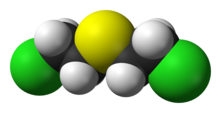Our website is made possible by displaying online advertisements to our visitors.
Please consider supporting us by disabling your ad blocker.
Mustard gas

| |

| |

| |
| Names | |
|---|---|
| Preferred IUPAC name
1-Chloro-2-[(2-chloroethyl)sulfanyl]ethane | |
| Other names
Bis(2-chloroethyl) sulfide
HD Iprit Schwefel-LOST Lost Sulfur mustard Senfgas Yellow cross liquid Yperite Distilled mustard Mustard T- mixture 1,1'-thiobis[2-chloroethane] Dichlorodiethyl sulfide | |
| Identifiers | |
3D model (JSmol)
|
|
| 1733595 | |
| ChEBI | |
| ChEMBL | |
| ChemSpider | |
| ECHA InfoCard | 100.209.973 |
| EC Number |
|
| 324535 | |
| KEGG | |
PubChem CID
|
|
| UNII | |
CompTox Dashboard (EPA)
|
|
| |
| |
| Properties | |
| C4H8Cl2S | |
| Molar mass | 159.07 g·mol−1 |
| Appearance | Colorless if pure. Normally ranges from pale yellow to dark brown. Slight garlic or horseradish type odor.[1] |
| Density | 1.27 g/mL, liquid |
| Melting point | 14.45 °C (58.01 °F; 287.60 K) |
| Boiling point | 217 °C (423 °F; 490 K) begins to decompose at 217 °C (423 °F) and boils at 218 °C (424 °F) |
| 7.6 mg/L at 20°C[2] | |
| Solubility | Alcohols, ethers, hydrocarbons, lipids, THF |
| Hazards | |
| Occupational safety and health (OHS/OSH): | |
Main hazards
|
Flammable, toxic, vesicant, carcinogenic, mutagenic |
| GHS labelling:[3] | |

| |
| Danger | |
| H300, H310, H315, H319, H330, H335 | |
| P260, P261, P262, P264, P270, P271, P280, P284, P301+P310, P302+P350, P302+P352, P304+P340, P305+P351+P338, P310, P312, P320, P321, P322, P330, P332+P313, P337+P313, P361, P362, P363, P403+P233, P405, P501 | |
| NFPA 704 (fire diamond) | |
| Flash point | 105 °C (221 °F; 378 K) |
| Safety data sheet (SDS) | External MSDS |
| Related compounds | |
Related compounds
|
Nitrogen mustard, Bis(chloroethyl) ether, Chloromethyl methyl sulfide |
Except where otherwise noted, data are given for materials in their standard state (at 25 °C [77 °F], 100 kPa).
| |
Mustard gas or sulfur mustard are names commonly used for the organosulfur chemical compound bis(2-chloroethyl) sulfide, which has the chemical structure S(CH2CH2Cl)2, as well as other species. In the wider sense, compounds with the substituents −SCH2CH2X or −N(CH2CH2X)2 are known as sulfur mustards or nitrogen mustards, respectively, where X = Cl or Br. Such compounds are potent alkylating agents, making mustard gas acutely and severely toxic.[3] Mustard gas is a carcinogen.[3] There is no preventative agent against mustard gas, with protection depending entirely on skin and airways protection, and no antidote exists for mustard poisoning.[4]
Also known as mustard agents, this family of compounds comprises infamous cytotoxins and blister agents with a long history of use as chemical weapons.[4] The name mustard gas is technically incorrect; the substances, when dispersed, are often not gases but a fine mist of liquid droplets that can be readily absorbed through the skin and by inhalation.[3] The skin can be affected by contact with either the liquid or vapor. The rate of penetration into skin is proportional to dose, temperature and humidity.[3]
Sulfur mustards are viscous liquids at room temperature and have an odor resembling mustard plants, garlic, or horseradish, hence the name.[3][4] When pure, they are colorless, but when used in impure forms, such as in warfare, they are usually yellow-brown. Mustard gases form blisters on exposed skin and in the lungs, often resulting in prolonged illness ending in death.[4]
- ^ FM 3–8 Chemical Reference handbook, US Army, 1967
- ^ Mustard agents: description, physical and chemical properties, mechanism of action, symptoms, antidotes and methods of treatment. Organisation for the Prohibition of Chemical Weapons. Accessed June 8, 2010.
- ^ a b c d e f "Mustard gas". PubChem, US National Library of Medicine. September 28, 2024. Retrieved October 4, 2024.
- ^ a b c d "Mustard gas fact sheet". World Health Organization, Eastern Mediterranean Region, Regional Centre for Environmental Health Action. 2024. Retrieved October 4, 2024.
Previous Page Next Page



